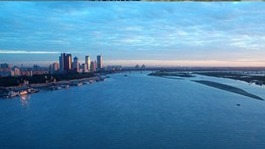Lanzhou, also known as Jincheng, Lu Du, or the City of the Yellow River. is the capital of Gansu Province, the second largest city , the center city and transportation hub in northwest China. It is home to the Lanzhou Military Region, one of China's seven military headquarters and Lanzhou Railway Bureau, one of the 18 major railway bureaus in China. In the north and south of the city downtown sits lots of mountains, with the Yellow River running through it. It is a strip basin city, located in the upper reaches of the Yellow River of the moderate continental climate. The average annual precipitation is 360mm, the average annual temperature 10.3 ° C, the average annual sunshine hours totaling 2,446 hours, frost-free period over 180 days.
Lanzhou is the only provincial capital city with Yellow River running through its downtown which is decorated by still hills and running waters, forming a distinctive and beautiful city landscape. As an important fulcrum in the western part of Longhai-Lanxin economic zone, Lanzhou is a pivotal transportation hub and logistics center and one of the top five cities in the Chinese section of the new Eurasian Land Bridge (Lanzhou, Xuzhou, Zhengzhou, Xi'an, Urumqi). It is a bridge between East and West China and the center of scientific research and education. Longhai, Lanxin, Qinglan, Baolan, these four major railways converge in Lanzhou, making it the largest freight station in Northwest China and the container transfer center on the new Eurasian Land Bridge It is also the hub of communication and information network center in the western region. Lanzhou boasts a distinctive geographic advantage that can reach to Shaanxi, Gansu, Ningxia, Qinghai, Xinjiang and Tibet and that is good for economic expansion. Lanzhou is a key city on the ancient Silk Road. As early as 5,000 years ago, inhabitants began to settle down there.
From Han to Tang and Song dynasty, with the opening up of the Silk Road, Lanzhou became an important transportation hub and commercial center on the Silk Road, a bond connecting western ethnic minorities, and played an important role in promoting economic and cultural exchanges between the East and the West. In Lanzhou, there were left a large number of places of interest that are attractive to tourists at home and abroad, making it the center to connecting such tourist attractions as the Mogao grottoes at Dunhuang, Maiji Mountain in Tianshui, Zhangye Grand Buddha Temple, Bingling Temple in Yongjing, Labrang Monastery in Xiahe. With the opening of the new Eurasian Land Bridge, especially the implementation of the grand western development program in China, Lanzhou is strategically crucial to connecting the East with the West to build a modern silk road.
